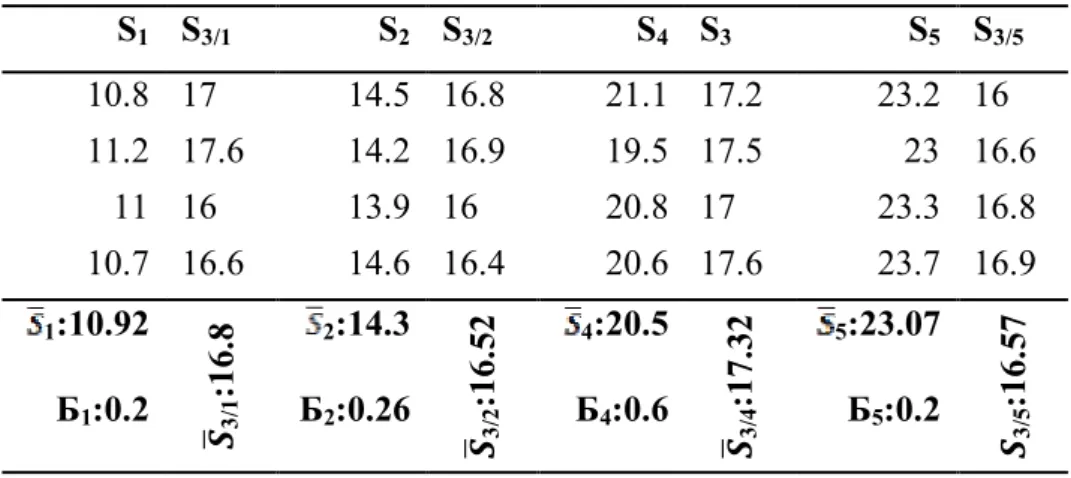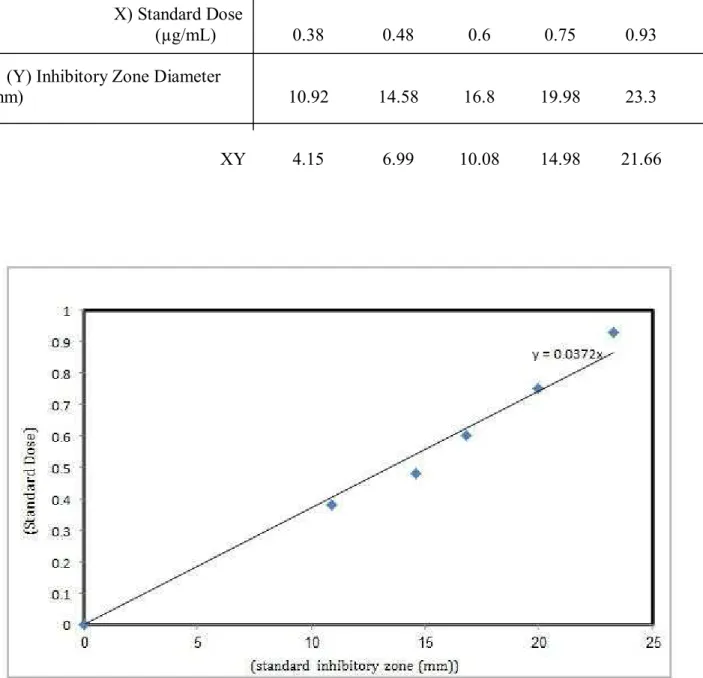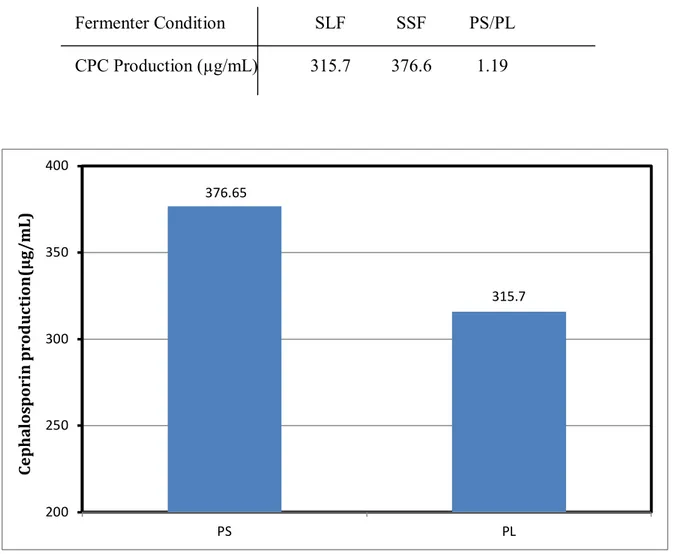REGULAR ARTICLE
COMPARATIVE EVALUTION OF CEPHALOSPORIN-C PRODUCTION IN SOLID STATE FERMENTATION AND SUBMERGED LIQUID CULTURE
Bahman Tabaraie1, Ehsan Ghasemian 2*, Termeh Tabaraie 3, Elnaz Parvizi2, Mahdi Rezazarandi4
Address:2*Ehsan Ghasemian, Department of Microbiology, Faculty of Science, Fars Science
and Research Branch, Islamic Azad University, Fars, Iran. Tel: +98-912-4652612;
1Kusha Faravar Giti, Industrial Research Institute of Biotechnology, Karaj, Iran
3Department of Microbiology, Karaj Branch, Islamic Azad University, Karaj, Iran
4Faculty of Medicine, Shahed University, Tehran, Iran
*Corresponding author: ghasemian.ehsan@gmail.com
ABSTRACT
The advantages of solid state fermentation (SSF) utilization in producing enzymes & secondary metabolites have been shown, whereas, submerged liquid fermentation (SLF) condition has the major usage in industrial production of antibiotics. As an antibiotic of B-lactams group, cephalosporin-C (CPC) is indicated due to its wide effect and broad convention in treatment of infectious diseases. Regarding industrial production of CPC regularly done in SLF condition, we compared CPC production sum in SLF and SSF conditions.
In this analysis, Acremonium chrysogenum was employed, which was inoculated to
SLF and SSF, while internal fermenter conditions were totally under control. After extraction of CPC, productions in two states of SLF and SSF were compared using the cylinder plate method.
the condition of solid state fermenter is more comfortable and practical than liquid state fermenter, using a solid based fermenter to produce antibiotics, especially CPC, can be appropriate. Considering appropriate control conditions of SSF to produce secondary metabolites, decrease in expenses, and increase of production, taking advantage of it in order to increase production parallel to modern methods, such as genetically manipulating CPC producing microorganisms are recommended to pharmacological industries. Also, to make this method applicable, further studies in industrial criterion seem necessary.
Keywords: cephalosporin-C, solid state fermentation, submerged liquid fermentation, cylinder plate method
INTRODUCTION
Major achievements were obtained in the 20th century in the field of biotechnology
and bioengineering which caused a development in industries, increase in production rate and
decrease in energy consumption and pollution (Adinarayana et al., 2003).
Like other B-lactam antibiotics, cephalosporin is a production of secondary metabolism of microorganisms, and industrial production was executed by conventional
methods of batch fermentation (Srivastava et al., 2006). On the other hand, it is possible to
increase antibiotic production and nutrient optimization using solid state fermentation (SSF) (Robinson et al. 2001). Incidence of multiple resistances to penicillin among organisms led to introduction of cephalosporin-C (CPC) to global pharmaceutical market as a significant antibiotic; hence penicillin and cephalosporin can cover roughly 65% of global antibiotic
production (Nigam et al., 2007).
Therefore it is important to adjust production mechanisms of secondary metabolites
and optimization of nutrients for various strains such as Acremonium chrysogenum and
streptomyces clavuligerus which produce cephalosporin (Nigam et al., 2007; Srivastava and Kundu., 1998; Srivastava et al., 2006).
Response Surface Methodology (RSM) is an important factor of optimizing of antibiotic fermentation conditions. So microorganism reactions to different types of nutrient layers have an important role in adherence, which can be evaluated by statistical analysis. According to initial studies, it is evident that CPC production is completely dependent on
fermenter content and RSM (Dasari et al., 2008) and this study determines whether SSF is
consumption and cost of the process (Dominguez et al. 2001; Robinson et al. 2001). DNA recombinant technique is applicable for modification and optimization of antibiotic
production (Hutchinso, 1994), on the other hand it is costly, time consuming and needs large
amount of energy. In addition, the genetic manipulation is unstable (Birch et al., 1990; Valita
et al., 1997). Therefore, classical techniques are still widely applicable to produce antibiotics. In this study CPC production with wild type A. chrysogenum was evaluated in order to eliminate errors and achieve reliable results for two different antibiotic fermentation methods; solid state and submerged liquid fermentation. Also, antibiotic assay technique was used to measure the production value for both methods and analyze the results.
MATERIAL AND METHODS
Organism
In order to produce CPC, Acremonium chrysogenum (PTCC 5271) (Persian Type
Culture Collection) was used without any genetic manipulation.
Seed inoculum
Inocula were performed by conduction 5 mL of suspension processed from a slant culture into 250 Erlenmeyer flasks containing 45 mL inoculum medium. The compund of the
inoculum was (g/L): yeast extract 4.0, soluble starch 15.0, K2HPO4, MgSO4 0.7 solved in
distilled water at a pH of 7.1 and then incubated on a rotatory shaker (Denville Scientific, Inc, Metuchen, USA) with a velocity of 220 rpm at 24 for 2days.
Solid state fermentation and submerged liquid fermentation of A. chrysogenum
Compounds used for solid state fermentation contained (g/L); sucrose 30, bagasse 10.0, ammonium nitrate 7.5, dipotassium hydrogen orthophosphate 15.6, DL-methionine 3.0, sodium phosphate 1.7, oleic acid 1.5, trace metal solution 6.5, calcium sulfate 3.5 at a pH of 7.2 by using 2M KOH and 2N HCL 49-51%, water activity 0.985 at 28°C. Then microbial
suspension with dilution of 108 spores/mL was added to 5% of the contents of fermenter
through the fermenter in order to aerate. It is noteworthy that contents of fermenter were
sterilized before adding to fermenter (Adinarayana et al., 2003; Wang et al., 1984).
Also to evaluate and compare the amount of CPC produced in solid state fermentation with submerged culture, attempted to provide the necessary ingredients for submerged culture
including (g/L); sucrose 36, Glucose 27, yeast extract 20, soybean oil 24.0, CaSO4 7.5, CaCO3
10.0, (NH4)2SO4 8.0, DL-methionine 3.0 solved in distilled water at a pH of 6.4 adjusted by
NaOH and sterilized (Valita et al., 1997).
Antibiotic extraction
Extraction was done at the end of fermentation. 50 mL of distilled water was added to the biomass and then the combination was shaken completely on a magnetic stirrer for 30 minutes, contents were filtered by muslin cloth, and the process was executed for the second time. The filters were pooled, centrifuged and the clear supernatant was considered as the antibiotic source.
Substrate
Sugarcane bagasse was prepared as the substrate. It took 2 days to dry in the open air with sunlight exposure. In order to obtain a suitable and equal particle size, the bagasse was grounded and then stored in air tight container for further use.
Antibiotic assay
Table 1 Different concentrations of standard cephalosporin- C. The standard cephalosporin-C
concentration was selected as the middle dose (S3: 0.6 µg/mL), and then four other doses were
defined according to that
S5 S4 S3 S2 S1 Standard Dose 0.93 0.75 0.6 0.48 0.38 Concentration (µg/mL)
RESULTS AND DISCUSSION
Measurement of cephalosporin inhibition zone
In this study production of CPC by A. chrysogenum (PTCC 5271) in SLF and SSF was examined by antibiotic assay and measuring the inhibition zone (Tab 2). International standard unit of cephalosporin was used to compare the inhibition zone of standard cephalosporin and yielded CPC in SSF and SLF Condition and results were presented in table
3, using Excel software (Fig 1).
Table 2 Inhibition zone diameters for standard cephalosporin- C concentrations. The average of inhibition zone for each concentration, in millimeter criterion, was measured and recorded, and then numeral analysis administered
S1 S3/1 S2 S3/2 S4 S3 S5 S3/5
10.8 17 14.5 16.8 21.1 17.2 23.2 16
11.2 17.6 14.2 16.9 19.5 17.5 23 16.6
11 16 13.9 16 20.8 17 23.3 16.8
10.7 16.6 14.6 16.4 20.6 17.6 23.7 16.9
1:10.92
3/
1
:16.
8 2:14.3
3/
2
:16.
52 4:20.5
3/
4
:17.
32 5:23.07
3/
5
:16.
57
Table 3 Median inhibitory zone diameter for each cephalosporin- C standard concentration. By consideration of the average data represented in (Tab 2), the axes "X" and "Y" was determined in order to draw standard cephalosporin- C curve and then regression index was calculated
0.93 0.75
0.6 0.48
0.38 (X) Standard Dose
(µg/mL)
23.3 19.98
16.8 14.58
10.92 (Y) Inhibitory Zone Diameter
(mm)
21.66 14.98
10.08 6.99
4.15 XY
Comparing and quantifying CPC in solid and liquid state phases:
According to standard CPC curves, concentration of yielded CPC from SLF and SSF was calculated per milliliter by considering inhibition zone (Tab 4) and comparative chart presented according to production in SLF (PS)/production in SSF (PL) (Tab 5) (Fig 2).
Table 4 Inhibitory zone diameter of produced cephaloporin-C in solid state fermentation (U1)
and submerged liquid fermentation (U2). The concentration of produced cephalosporin- C in
solid state fermentation and submerged liquid fermentation which is determined on the basis of inhibition zone and standard cephalosporin- C curve is shown below
U1 S3 U2 S3
9 16 10.1 16
9.2 16.6 11 16
9.5 16.5 11.2 16.5
10.1 17 12 16.6
1: 9.45
X1
: 9
.43
2: 11.07
X2
: 11
.25
БU1: 0.41 FU1: -0.02
3: 16.25
БU2: 0.67 FU2: 0.18 3: 16.32
PL (µg/ml): (3.157) 100: 315.7 PS (µg/ml): (3.766) 100: 376.6
Antibiotics are one of the secondary metabolites produced by bacteria, since they are produced during idiophase, they are called idiolites. After discovering penicillin, a great promotion in treatment using antibiotics was discovery of cephalosporin C, a β-lactam compound produced by A. chrysogenum. It was shown that cephalosporin C presented a wide
Table 5 Cephalosporin-C production in submerged liquid fermentation (PS)/ production in solid state fermentation (PL) ratio. The concentration of produced cephalosporin-C in solid state fermentation and submerged liquid fermentation were analyzed on the basis of inhibition zone, also the amount of production for each condition was compared
376.65
315.7
200 250 300 350 400
PS PL
Ce
ph
al
os
po
ri
n
pr
od
uc
ti
on
(µ
g/
m
L)
Figure 2 Cephalosporin-C production in solid state fermentation (PS) was compared to submerged liquid fermentation (PL)
A comparison between the amount of produced penicillin of different strains in both SSF and SLF phases shows that bacteria and fungi grown on SLF are more capable of
producing secondary metabolites than same strains grown on SLF (Barrios-Gonzalez et al.,
1993; Barrios-Gonzalez et al., 1998).
Bacterial infections are increasing rapidly, and consequently, the necessity of antibiotic is rising. For this reason, research center and pharmaceutical companies try to find cost effective methods, increase the outcome and preserve product quality. Choosing a suitable substrate for fermentation and also coincident strains are so important in case of
PS/PL SSF
SLF Fermenter Condition
1.19 376.6
higher amount of CPC production (Muñiz et al., 2007). The outcome of cephalosporin production in SSF is more in SLF, because microorganisms grew in a medium that is more
similar to its natural habitat (Adinarayana et al., 2003; Barrios-Gonzalez et al., 1993;
Manpreet et al., 2005), so in this study solid state fermenter was used to produce cephalosporin.
As previous results show, CPC production will be maintained in maximum rate during the entire idiophase in the ideal feeding condition. Also studies showed that quantities of CPC
production by A. chrysogenum in SSF condition are more than production of CPC in SLF
conditions (Srivastava et al., 2006).
It is remarkable that control of solid state fermenter condition is easier than control of Liquid state fermenter and also production process of secondary metabolism has less limitations, such as: better control of fermenter tank aeration and moisture, in addition to removal of limitation for the size of bioreactors, less energy waste, decrease in time of process and elimination of liquid wastes. It should be noted that different solid state fermenters have
the ability to produce cephalosporin in different conditions (Adinarayana et al., 2003;
Barrios-Gonzalez et al., 1990; Robinson et al., 2001).
Studies have shown that penicillin production is strongly dependent on size of sugar bagasse substrate (Barrios-González et al. 1993), so that large particles in SSF significantly
increase penicillin production (Dominguez et al., 2001). Byproducts of agricultural activities
can be directly used as substrate or after processing, so some of the substrates should be
treated which is more available and cheaper to use than to synthetic substrates (Adinarayana
et al., 2003; Shankaranand et al., 1992). In this study, processed sugarcane bagasse was used as substrate which led to satisfying results of CPC production from A. chrysogenum.
Generally, recent studies have shown that strains with high level of enzyme production in SLF are less efficient producers in SSF, but other studies indicate that strains with high
production of penicillin in SLF have high production in SSF too (Barrios- Gonzalez et al.,
2005; Hölker et al., 2004; Shankaranand et al., 1992) and filamentous fungus are the best organisms to adapt SSF conditions.
However, amount of produced secondary metabolites indicate the relation between
fermenter media and the type of selected organisms (Barrios-Gonzalez et al., 1993;
Raimbault, 1998). Results showed higher potential of antibiotic production of strains in SSF
conditions; also in this study increased rate of CPC production by A. chrysogenum is
previous studies. It should be noted that there is a logical relation between SSF and SLF in levels of produced secondary metabolites for most of microorganisms.
CONCLUSION
According to the previous studies and present study on production of CPC, it is concluded that using SSF is more suitable than SLF to produce of antibiotics by filamentous fungi. Some criteria were considered for this conclusion; increasing outcome, better control of solid state fermenter conditions and decreasing the cost. Also, since the content of fermenter is important, it is worthy to find a suitable content. There is no direct relation between CPC production capacity of a strain in SSF and SLF conditions, and a strain's potential is the main factor of maximum CPC production in SSF.
Although a classic technique was used in this study, modern techniques induced genetic variations, and selecting potent strains play an important role in production of antibiotics. So it is suggested that, efficient strains can be designed by combination of classic and modern techniques, in order to achieve commercial pharmaceutical aims. On the other hand, industrial production of antibiotics is beneficial, so developing countries have to investigate on this industry, which is achievable by scientific capacity, native facilities, and cooperation of developed countries. Technology of antibiotic production in SSF can be shifted to other biopharmaceutical products and secondary metabolite industries; fulfillment of these goals needs further investigations.
Acknowledgements: The authors express their sincere gratitude and gratefully acknowledge Kusha Faravar Giti Co. for technical assistance and financial support. We thank Arash Eyn Abed for his helpful advice and statistical analysis.
REFERENCES
ADINARAYANA, K. - PRABHAKAR, T. – SRINIVASULU, V. – ANITHA, R. M. – JHANSI, L. P. – ELLAIAH, P. 2003. Optimization of process parameters for cephalosporin
C production under solid state fermentation from acremonium chrysogenum. In Process.
BARRIOS-GONZALEZ, J. – CASTILLO, T. E. – MEJIA, A. 1993. Development of high
penicillin producing strains for solid state fermentation. In Biotechnol. Adv., vol. 11, 1993,
no. 3, p. 525-37.
BARRIOS-GONZALEZ, J. – FERNANDEZ, F. J. – TOMASINI, A. – MEJIA, A. 2005.
Secondary metabolites production by solid- state fermentation. In Malaysian J. Microbiol.,
vol. 1, 2005, no. 1, p. 1- 6.
BARRIOS-GONZALEZ, J. – GONZALEZ, H. – MEJIA, A .1993. Effect of particle size, packing density and agitation on penicillin production in solid state fermentation. In Biotechnol. Adv., vol. 11, 1993, no. 3, p. 539-47.
BARRIOS-GONZALEZ, J. – RODRIGEEZ, G. M. – TOMASINI, A .1990. Environmental and nutritional factors controlling aflatoxin production in cassava solid state fermentation. In J. Ferment. Bioeng., vol. 70, 1990, no. 5, p. 329-333.
BARRIOS-GONZALEZ, J. – TOMASINI, A. - VINIEGRA- GONZALEZ, G. – LOPEZ, J. 1998. Penicillin production by solid state fermentation. In Biotechnol. Lett., vol. 10, 1998, no. 11, p. 793- 798.
BIRCH, A. – HAUSLER, A. – HUTTER, R. (1990) Genome rearrangement and genetic instability in streptomyces spp. In J. Bacteriol., vol. 172, 1990, no. 8. p. 4138- 4142.
DASARI, V. R. R. K. – DONTHIREDDY, S. R. R. – NIKKU, M. Y. – GARAPATI, H. R.
2009. Optimization of medium constituents for Cephalosporin C production using response
surface methodology and artificial neural networks. In J. Biochem. Tech., vol. 1, 2009, no. 3, p. 69- 74.
DOMINGUEZ, M. – MEJIA, A. – REVAH, S. - BARRIOS-GONZALEZ, J. 2001. Optimization of bagasse, nutrients and initial moisture ratios on the yield of penicillin in solid- state fermentation. In World J. Microbiol. Biotechnol., vol. 17, 2001, no. 7, p. 751- 756. HOLKER, U. – HOFER, M. – LENZ, J. 2004. Biotechnological advantages of laboratory-scale solid-state fermentation with fungi. In Appl. Microbiol. Biotechnol., vol. 64, 2004, no. 2, p. 175- 186.
HUTCHINSO, C. R. 1994. Drug synthesis by genetically engineered microorganisms. In Nat. Biotechnol., vol. 12, 1994, p. 375- 380.
MUNIZ, C. C. – ZELAYA, T. E. C. – ESQUIVEL, G. R. – FERNANDEZ, F. J. 2007.
Penicillin and cephalosporin production: A historical perspective. In Microbiologia, vol. 49,
2007, no. 3-4, p. 88-98.
NIGAM, V. K. – VERMA, R. – KUMAR, A. – KUNDU, S. – GHOSH, P. 2007. Influence of medium constituents on the biosynthesis of cephalosporin-C. Electron. In J. Biotechnol., doi: 10.2225.
RAIMBAULT, M .1998. General and microbiological aspects of solid substrate fermentation. In Electron. J. Biotechnol., vol. 1, 1998, no.3, p. 1-15.
ROBINSON, T. – SINGH, D. - NIGAM, P. 2001. Solid-state fermentation: a promising
microbial technology for secondary metabolite production. In Appl. Microbiol. Biotechnol.,
vol. 55, 2001, no. 3, p. 284-289.
SHANKARANAND, V. S. – RAMESH, M. V. – LONSANE, B. K. 1992. Idiosyncrasies of solid-state fermentation systems in the biosynthesis of metabolites by some bacterial and fungal cultures. In Process. Biochem., vol. 27, 1992, no. 1, p. 33-36.
SRIVASTAVA, P. – KUNDU, S. 1998. A comparative evaluation of Cephalosporin C
production using various immobilization modes. In J. Gen. Appl. Microbiol., vol. 44, 1998,
no. 2, p. 113-117.
SRIVASTAVA, P. – MISHRA, P. - KUNDU, S. 2006. Process strategies for cephalosporin C fermentation. In J. Sci. Ind. Res., vol. 65, 2006, no. 7, p. 599-602.
VALITA, A. – FERREIRA, C. – JUNIOR, R. B. – AZEVEDO, J. L. 1997. Cephalosporin C
production and genetic improvment of the fungus Acremonium chrysogenum based on
morphological mutant isolation. In Braz. J. Genet., vol. 20, 1997, no. 2, p. 165- 170.
WANG, H. H. – CHIOU, J. Y. – WANG, J. Y. – HONG, C. Y. – TSEN, W. C. 1984.
Cephalosporin C production by solid state fermentation with rice grains. In Zhonghua Min


